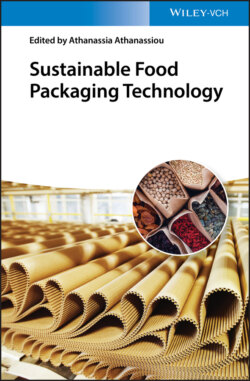Читать книгу Sustainable Food Packaging Technology - Группа авторов - Страница 22
1.3.7 Poly(ethylene furanoate)
ОглавлениеA potential green substitute for terephthalic acid is 2,5‐furandicarboxylic acid (FDCA), which is a bio‐based building block that can be polymerized with bio‐MEG to form a new 100% bio‐based polyester called poly(ethylene furanoate) (PEF) [85]. PEF can be synthesized by polycondensation, ROP, and solid‐state polymerization. Polycondensation is the most commercially relevant method but it results in long exposure times to high processing temperatures, around 200 °C, which increases the production cost and, even more importantly, leads to thermal degradation and discoloration of the biopolymer. Solid‐state polymerization (SSP) is a milder process, though a bottle‐grade PEF has not been achieved yet [86]. SSP involves heating of the starting partially crystalline polyester at a temperature between its Tg and Tm, which is used mainly for PET manufacturing to get over its relatively low MW [87]. The company Avantium is developing PEF using bio‐MEG and FDCA coming from the dehydration of carbohydrates [77]. In 2016, it was announced a new technology involving a highly efficient separation technology and catalyst that would result in economically feasible production of FDCA starting from 2016. The planned industrial production capacity is estimated to exceed 300 000 tons per year while the company has established collaborations with major endusers from the food and beverage industry [84].
PEF shows excellent thermal properties and lower Tm values than PET because of which it can be processed at lower temperatures. It has the ability to withstand high temperature due to its higher Tg as well as thermal stability up to 320 °C. PEF outperforms the barrier properties of PET. Specifically, PEF's O2 barrier is more than ten times higher than that of PET, the CO2 barrier is four times higher, and the water vapor barrier is two times higher [88]. Other attractive properties of PEF include excellent mechanical strength, reduced carbon footprint, and ability to formulate in films, fibers, and almost replace PET in water bottles [87]. PEF can be recycled in very similar ways to PET [88]. Recently, the enzymatic synthesis of FDCA‐based polyesters was studied by the groups of Loos and Boeriu with Candida antarctica lipase B [89, 90]. However, apart from numerous reports around the emerging topic of PEF production and application, there is no information on enzymatic hydrolysis of PEF. Nevertheless, especially for bio‐based PEF, biotechnological processing for functionalization and chemical recycling of monomers could have a large potential to replace harsh chemicals [84].
